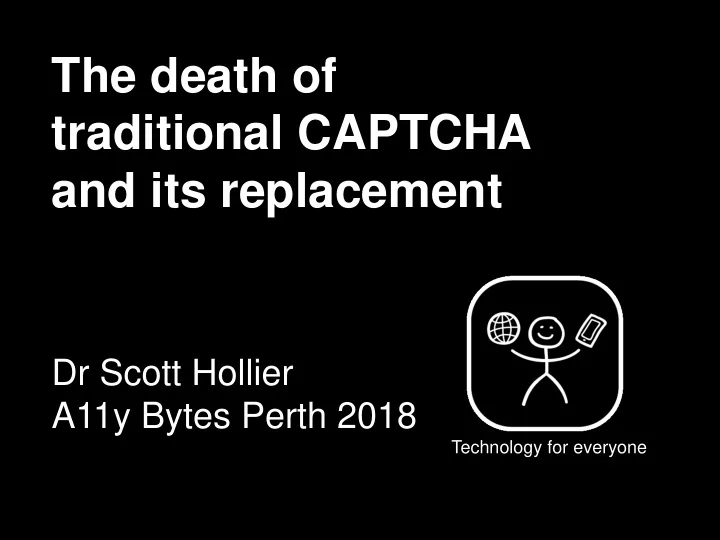

The death of traditional CAPTCHA and its replacement Dr Scott Hollier A11y Bytes Perth 2018 Technology for everyone
What is CAPTCHA? • Completely Automated Public Turing test to Tell Computers and Humans Apart (CAPTCHA) • Purpose: to stop bots from harvesting data
Traditional CAPTCHAs • Task: to identify a distorted set of characters from a bitmapped image, then enter those characters into a form.
CAPTCHAs and web accessibility • Impossible for people with low vision • Incompatible with screen readers making it impossible for blind users • Assumes familiarity with the English character set • Not intuitive making it difficult for people with cognitive disabilities • Alternatives can be difficult too
Traditional CAPTCHA issues
Audio CAPTCHA • Do you type in ‘9’, ‘Nine’ or ‘nine’?
W3C WAI APA RQTF • Research Questions Task Force (RQTF) has researched CAPTCHAs and accessibility to update 12-year- old CAPTCHA advice document • I’ve authored most of the new revision currently pending approval
Findings • 20% of traditional CAPTCHAs can be cracked easily • This figure is much higher using pattern-matching algorithms • Not only are traditional CAPTCHA solutions (visual, audio) inaccessible but also insecure
Best practice • reCAPTCHA checkbox • Federated identity • Multiple devices with biometrics • E-mail verification
reCAPTCHA checkbox • reCAPTCHA works by monitoring human movement. Works well for security and accessibility but defaults to inaccessible CAPTCHA if not sure.
reCAPTCHA in action
Conclusion • Traditional CAPTCHAs are not just inaccessible but also no longer secure • reCAPTCHA checkbox good but has inaccessible fallback • Other mechanisms such as federated identity, multiple devices and biometrics are best practice
Further information • E-mail: scott@hollier.info • Website: hollier.info • Mobile: +61(0)430 351 909 • Twitter: @scotthollier • Newsletter: newsletter@hollier.info • Book: outrunningthenight.com
Recommend
More recommend